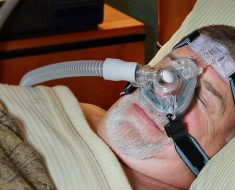At last! High-tech cancer treatment that saved Ashya King is in Britain – here, we speak to the first person who’s had it (for prostate cancer)
- Simon Hardacre was diagnosed with aggressive form of prostate cancer in 2017
- He knew that surgery carried the high risk of both incontinence and impotence
- But became first person to be treated with same method that saved Ashya King
Surgery or radiotherapy. These were the two options presented to Simon Hardacre when he was diagnosed with an aggressive form of prostate cancer last year. Neither appealed.
He knew that surgery carried the risk of incontinence and impotence. And he’d been treated with radiotherapy for throat and neck cancer six years previously, and had no desire to repeat the experience.
‘I knew I couldn’t go through it again,’ says Simon, 56, a company director from Woolaston in Gloucestershire.

UK-first: Simon Hardacre photographed at his home near Chepstow with partner Maria
‘Radiotherapy was horrendous, and at times I wanted to curl up and die as I felt so sick. I couldn’t swallow, so had to be fed via a tube into my stomach. My neck was also very sore.
‘It took about 13 months to fully recover and to regain my appetite.’
But then he was offered a third option, and three months ago Simon became the first person in the UK to be treated with high-energy proton beam therapy.
-

‘I had no clue men could get breast cancer’: Magician, 68,…
I can help you beat breast cancer: Angelina Jolie¿s surgeon…
Brave toddler battling OVARIAN CANCER: 15-month-old has a…
Rescued Thai cave boys face a lifetime of trauma from their…
Share this article
‘I had no idea I’d be the first person to have it in Britain,’ he says. ‘But I really didn’t want another treatment which could possibly leave me with incontinence issues or impact on my love life.
‘I’m convinced if I’d undergone a different treatment, I wouldn’t feel as well as I do.’
Proton beam therapy is a type of radiotherapy. But rather than using X-rays, like the conventional type, the radiation that destroys tumour cells comes from protons, which are tiny, positively charged particles.

Test: Ashya King, then five, underwent in 2014 for medulloblastoma, a type of brain tumour
The particles are ‘accelerated’ to a speed of 100,000 miles a second and then fired at the tumour. It is thought to be more precise and so less damaging to surrounding, healthy tissue than conventional radiotherapy, meaning fewer side-effects.
In most cases, the patient would have the same number of proton beam sessions as with radiotherapy.
It has only just been introduced to the UK with the opening of the first private proton beam centre, while two nhs centres will be operational soon.
Simon was treated at the Rutherford Cancer Centre in Newport, South Wales, which started giving patients proton beam therapy in April. Other private centres are being built at Liverpool and Reading.
High-energy proton beam therapy itself is not new. However it has, till now, been unavailable in this country. Instead, the NHS has been paying for some patients to have the treatment abroad since 2008, at specialist centres in Jacksonville, Florida, and Oklahoma City in the U.S., as well as Switzerland, at a cost of around £110,000 per patient.
This is the treatment that Ashya King, then five, underwent in 2014 for medulloblastoma, a type of brain tumour.
His parents were arrested in Spain after removing him from Southampton General Hospital, where doctors had wanted to treat their son more conventionally with radiotherapy and chemotherapy.
But a court later ruled that Ashya could undergo proton beam therapy in Prague, and earlier this year his family told the Mail that Ashya no longer had any signs of tumours in his body.
A slightly different lower-energy form of proton beam therapy has also been available since 1989 at the Clatterbridge Cancer Centre, an NHS hospital in The Wirral, to treat some rare eye cancers.

Success: Simon is the first adult in the UK to be treated with proton beam therapy for prostate cancer which has, so far, been successful…
Proton beam therapy is generally used for cancers in hard-to-reach areas or where it is near particularly vulnerable tissue, such as the optic nerve or spinal cord. It is also used to treat some cancers in children, often brain tumours.
‘Proton beam therapy means treatment for some cancers can be more precise,’ says Dr Justine Alford, senior science officer at Cancer Research UK.
This is because protons only release their energy (which is what kills cancer cells) when they hit their target — unlike X-rays in conventional radiotherapy, which release radiation as they travel, causing damage to healthy tissue en route. This is what causes side-effects.
‘Scientists can map exactly where the protons need to go in the body and calculate their trajectory, so that they stop before releasing a huge burst of energy against the tumour,’ explains Dr Alford.
‘They don’t release any energy before this, so they’re not causing harm on entry to the body or after hitting the tumour.’
So why are we only now getting proton beam therapy centres in the UK?
The main barrier has been the enormous cost of the equipment. The NHS centres due to open at The Christie Hospital in Manchester next year and at University College Hospital in London in 2020 are reported to have cost £250 million.
A British Medical Journal article in 2012 stated that the cost of proton beam treatment for prostate cancer, for example, is roughly twice as much as conventional radiotherapy — and three times as much as surgery.
And this has weighed against the argument for proton beam therapy. Because, so far, there is no data to suggest it is any better at actually killing the cancer or improving survival rates.
‘It isn’t a miracle cure,’ says Dr Alford. ‘It might have a lower risk of side-effects, but this doesn’t mean it is more likely to destroy the cancer.’
Simon came across proton beam therapy while researching alternative treatments for his prostate cancer.
The diagnosis itself had come as a shock.
‘I went to see my GP because I was feeling stressed and run down in July last year,’ says Simon, who lives with his partner Maria, 40, and their two sons from previous relationships, both aged 11.
Tests revealed Simon’s level of prostate-specific antigen (PSA) — a protein produced by the prostate — was raised, which can be an indicator of cancer. So he was referred for a biopsy.
‘Two months later, I was told I had a form of prostate cancer that was likely to grow and spread, and so it could not be left untreated,’ says Simon.
‘I couldn’t believe I’d been dealt another cancer blow,’ he says. ‘I was quite tearful. But after the initial shock I picked myself up and considered my options. I remembered the story of Ashya King. I’d read that proton beam therapy did not damage so much of the healthy tissue and I contacted the Prague clinic which treated Ashya.’
Simon had been about to book at the Prague clinic when he saw an online advert for the Rutherford Cancer Centre, which was only about a 30-minute drive from his home and due to open soon.
PROTON BEAM THERAPY: THE FACTS
Proton beam therapy is a form of radiotherapy and, like all radiotherapy, it works by damaging cancer cells’ DNA.
The difference is that the proton beam of radiation only releases its energy when it hits the cancerous tissue; it then stops, meaning less damage to surrounding tissue.
This is why it’s thought to be more suitable for cancers in particularly vulnerable areas, such as the brain.
– The tiny particles — called protons — that destroy the cancer cells are ‘accelerated’ in huge machines to a speed of 100,000 miles per second to create the high-energy beam.
– It’s hoped that the two NHS proton beam centres due to be operational by 2020 — one in London, one in Manchester — will treat 1,500 patients a year. Currently, the NHS sends about 100 people abroad for the treatment.
– One in 100 people with cancer would be suitable for proton beam therapy, according to Cancer Research UK, although some experts have suggested it could be as many as one in ten of those who receive conventional radiotherapy currently.
– It is only suitable for solid tumours rather than blood cancers such as leukaemia — and, according to the NHS, is considered most suitable for tumours in the brain or spine, or complex childhood cancers, where the risk of serious side-effects is greatest.
– A treatment session generally takes 15 to 45 minutes, similar to radiotherapy.
– The machine that generates the protons is huge. Called a cyclotron (the one pictured here is at the Prague cancer centre where Ashya King was treated), it weighs 90 tonnes.
– Installing it requires digging a hole approximately 30 metres deep to house the equipment and the construction of concrete walls to encase it. The one in Manchester sits in a bunker reinforced with timber, steel and concrete.
– The treatment itself is usually painless.
‘I met the oncology team in January this year and I was told I would have a session every weekday morning for 20 days,’ explains Simon. ‘They said that after a daily dose of proton beam therapy, I could just get on with my normal life. It sounded amazing.’
The downside was the cost — more than £65,000.
Fortunately, Simon’s younger brother John, 54, who runs a property company with him, offered to lend Simon most of the money.
‘I tried other ways of raising the money and even asking if the NHS would pay, without any luck,’ says Simon. ‘I was really touched by John’s gesture.’
Before beginning proton treatment, Simon had a short course of hormone treatment to reduce his testosterone levels, as this can drive cancer growth. (It is typically given to men who have conventional radiotherapy, too.)
For the proton beam therapy, first a CT scan is carried out to make sure the beam will hit the correct spot.
The beam is then delivered via a device mounted on a gantry above the patient.
‘The first time, I didn’t even realise it had happened,’ says Simon. ‘I soon learnt that the faint clicking sound that lasted 30 seconds was the proton beam being fired, but I still didn’t feel a thing.’
Towards the end of his treatment, Simon suffered some slight side-effects — struggling to urinate and feeling more tired than normal. However, these went away within two weeks of finishing the treatment.
‘The side-effects were so much less than with the radiotherapy I had for my other cancer,’ says Simon. ‘It really didn’t have a major impact on my life like before.’
Simon will not know if the treatment has worked until next month, when he has another PSA test.
Although there is not yet a depth of studies, proton beam is ‘at least as effective as conventional radiotherapy when it comes to curing some prostate cancer’, according to Dr Jason Lester, a consultant clinical oncologist at The Velindre Cancer Centre in Cardiff and Simon’s consultant at the Rutherford Cancer Centre.
‘There is evidence to show proton beam therapy is safe in prostate cancer patients and is a good treatment option for some, depending on how aggressive it [the cancer] is,’ he says.
‘It results in reduced radiation in normal healthy tissue around the prostate. We hope this will translate into fewer long-term side-effects.’
So will proton beam one day be the norm for treating cancer?
‘Conventional radiotherapy does a very good job at treating a number of cancers and is an invaluable treatment,’ says Dr Alford.
‘For many cancers, the cost of proton beam therapy wouldn’t be justified.
‘And with only two [NHS] centres opening in the UK, as it stands, then the ability of the NHS to cope with extra demand would also need to be factored in.’
Simon, meanwhile, is feeling positive. ‘As treatment for cancer goes, it could not have gone better,’ he says. ‘It’s now just a case of fingers crossed until my next appointment.’
Source: Read Full Article





